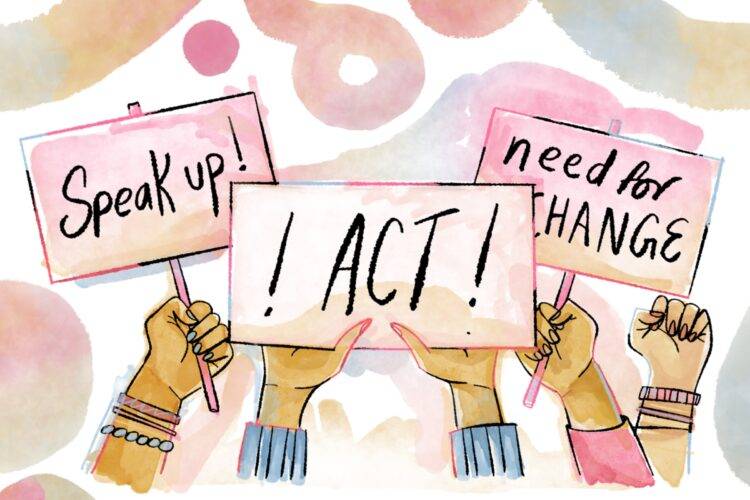
Last April, students at Columbia University protesting in support of Palestine made national news when the school called on the New York Police Department to disband an encampment. Forty-six students were arrested, causing a massive backlash that reverberated across the country and beyond. Campus protests have led to over 3,100 arrests in the United States, including arrests at the School of the Art Institute of Chicago.
Student protests have a long history — from the Civil Rights Movement, to the opposition of American involvement in the Vietnam War, to the South African anti-Apartheid protests. Though the war in Gaza is at the epicenter of student protests in 2024, modern student demonstrations go beyond one issue, centering also on gun control policies, environmental issues, racial justice, and labor rights.
At the start of the 2024-25 school year, SAIC released a student demonstration policy in this year’s student handbook from the Office of Student Affairs. Last year’s handbook did not have a written policy on student demonstrations, making this a notable change that could affect any students participating in protests or demonstrations on campus. As of the publication of this article, there has not been an official announcement of these new policies.
What does the new student demonstration policy mean for students?
The new policy states:
We support and encourage the expression of one’s beliefs, including viewpoints that may be considered unorthodox or unpopular. While students are free to express opinions individually or as part of an organized group, those opinions must only be expressed in a manner that is peaceful and that respects the rights of others without endangering the safety of the community or disrupting campus operations or programming. SAIC reserves the right to determine the time, place, and manner of demonstrations, events, and other displays of free expression on its property to ensure that there are no safety concerns and that there is no disruption of SAIC operations, interference with other campus activities, or obstruction of the rights of others who may have opposing viewpoints. This policy establishes the parameters that students must adhere to when engaging in free expression and peaceful demonstrations on campus.
The specifics that follow emphasize student and campus safety, which interim vice president and dean of student affairs Debbie Martin echoed when speaking with F News.
“It is based on a simple premise: Opinions should be expressed peacefully and with respect to the rights of others; and that protests should not endanger members of our community or disrupt the ability to carry out the School’s mission,” said Martin.
Two key points of note within these seven guidelines are the ones labeled “Facilities and Approval Process” and “Solicitation and Distribution of Materials.”
The former states, “The 280 Pit is the only space on campus where students are permitted to stage a group demonstration or protest.” It outlines a process for requesting to use the 280 pit for a demonstration. The 280 pit is not easily accessible for students who are unable to use stairs.
“As an urban campus in a very dense environment, we have very limited options for hosting large gatherings in a safe manner and without disruption to classroom activities. The 280 pit is the only space on campus that meets those criteria,” said Martin. She added, “Our goal was to provide students with a transparent and easy-to-navigate process.”
In addition, the museum campus is now fully off-limits for demonstrations, which means students protesting on the steps of the AIC will not be permitted.
The new solicitation and distribution of materials guidelines ban students, employees, and staff from distributing “non-museum or school sanctioned materials on its premises.”
This raises the question of what counts as distribution. Can print media and comics students still distribute ‘zines? What about groups like the Art Institute of Chicago Workers Union, which gives out stickers in support of the faculty union?
The policy concludes with a statement saying that students or student groups violating the new policy will be “adjudicated under SAIC’s Student Conduct Procedures,” but that each case is “context-specific.”
According to Martin, the new policy was developed over the summer and reviewed by the student government.
“The demonstration policy is meant to create flexibility to allow for our active students to schedule their demonstrations in a safe and conducive environment and simplify the roles of working campus members like Security and other Student Affairs staff, ” reads the student government’s statement on the policy.
Reactions to the new policy
For many, the news of this policy broke via Student Government’s Instagram post which includes the policy and their statement. As of Sept. 18, the post has 38 likes and 24 comments, accounting for only a small fraction of the student body. The majority of the comments are negative and express anger or frustration.
“My immediate reaction was, ‘Wow, our school is afraid,’” said M, an undergraduate student, who found out about the new policy through the student government’s post. (M asked to remain anonymous for fear of retribution.) M has been involved with SAIC Students for Palestine Liberation, The People’s Art Institute, and the newly forming Jewish Voices for Peace.
SPL and PAI hadn’t responded to requests for comment by the time of publication.
“I was really discouraged to see the new rules surrounding how the 280 pit has to be used. I’ve yet to see a demonstration happen at the 280 pit. I really think of the 280 pit as one of the very few free-gathering spaces that exist on our campus,” said M.
M added that SAIC doesn’t have a field, a quad, or many casual meeting places, and that they worried the new policy might strip the pit of some of its spontaneity and life.
Danny Floyd, a Visual and Critical Studies professor who is on AICWU’s bargaining committee, said that AICWU protests have and will never put anyone’s safety at risk and that he felt the new policy seems to “undermine students’ ability to be public about their opinions,” Floyd said.
Keefer Dunn, who teaches in the Architecture department and is also a bargaining member of AICWU, drew attention to the vague language used in the policy.
“When you have a policy that is so broad where anything can be deemed as disruptive or unsafe, that has a really chilling effect on student activism, which is I think a really important part of having a school community that is focused on making the world a better place,” Dunn said.







